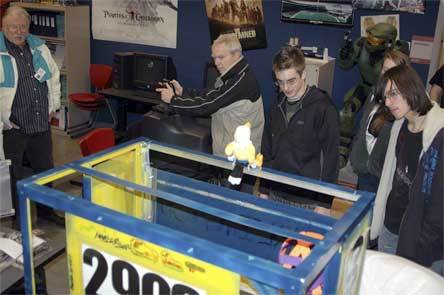ARLINGTON — A new rivalry is forming between two high schools, but it’s not on any sporting field — it’s in the classroom.
More specifically, it’s in robotics.
“They did really well for a rookie team last year,” said Shaun Hensler, a Marysville-Pilchuck graduate and former robotics team member who now volunteers his time with Arlington High School’s team. “It’s kind of a friendly competition.”
Although both school teams are competing against each other, that hasn’t stopped either group from helping each other out while working toward a common goal, which is taking home first prize in the FIRST Robotics Competition in March 2010 at Key Arena in Seattle.
Building on previous experience, members of both school teams are beginning to gear up for this year’s annual robot build season, which begins in January and culminates in the competition.
The event requires teams to design and construct a robot that can complete a specific task. The robot that can do that job the best is crowned the winner.
“Last year I drove (our) robot, and it’s crazy because there are literally thousands of people watching you and wanting you to fail or win,” said Michael Calkins, Marysville-Pilchuck senior and this year’s team leader. “The pressure shows you what kind of person you are.”
Last year the event required teams to build remote-controlled robots that could collect plastic balls.
Marysville-Pilchuck’s team tied for second place, while Arlington placed 32nd of 64 teams.
This year’s ‘game,’ as students refer to it, will be announced Jan. 9. Participating teams will then have six weeks to design and construct their robots. Clubs can either purchase a kit offered by organizers, use their own parts, or any combination of the two, said Arlington club mentor Glenn Frable.
“Right now we’re experimenting with old parts that we didn’t use last year,” said Frable, a volunteer for the club who also works in airplane systems computing for Boeing. “Up until the kickoff event, it’s all just preparation.”
In addition to the students learning technical skills, robotics students learn how to work as a team to solve problems, said Brett Sarver, career and technical education director at Arlington High School.
Sarver said last year the Arlington team spent four weeks trying to get their robot to work. After no success, Sarver said one girl on the team simply asked him how to do it.
“I said ‘I don’t know,’” Sarver said. “It’s like she thought I was holding the answer back from her.”
Once the students realized that there was not a simple answer, they began to have success, he said.
In addition to working on the technical side of building a robot, such as programming or engineering, the Arlington and Marysville-Pilchuck teams have team members strictly devoted to business and public relations.
Brittney Schopf, a senior at Marysville-Pilchuck, said she doesn’t know much about programming a robot, but that hasn’t stopped her from becoming the team’s public relations leader.
Her duties include making banners, printing T-shirts and writing thank you letters to sponsors.
“There are so many different components to it,” Schopf said.
Marysville-Pilchuck started its robotics club during the 2007-08 school year and Arlington followed suit last school year. The Marysville team has about 30 members in its club, while Arlington has 22.
Both teams are looking to build on their respective finishes this year.
“Last year we had to really teach students,” said Grice. “This year students are more confident. We don’t have set people doing different tasks — we’re encouraging people to step up and try new things.”
Both after-school clubs are currently soliciting donations and sponsors for their teams. For more information, contact either Marysville-Pilchuck mentor Mike Fitzpatrick at 360-658-0734 or Sarver at 360-618-6300.



